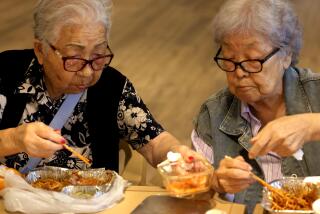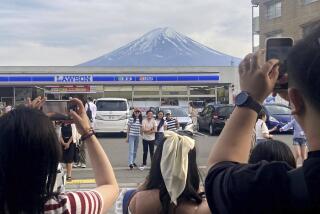Japanese Seniors Are Taking to Life in the Electronic Village
- Share via
YAMADA, Japan — The phone rings, and Nobutsune Tanaka, 83, suddenly sees Fumiko Yamazaki, 66, appear on his computer screen. “I can see your beautiful face,” he tells her.
Every second or so, another frozen image of her flutters across the screen, as the two friends in this tiny mountain village converse by phone.
The technology, involving small video cameras mounted above personal computers, isn’t rocket science. But in many ways, the PCs installed at government expense in nearly every home have revolutionized this isolated mountain village on Japan’s northwest coast.
The village also has become a laboratory of sorts for automating and delivering health care for the elderly, who constitute about one-quarter of the village’s population.
Older residents’ vital signs--pulse, blood pressure and heart rate, which they record at home with the help of machines that verbally explain to them what to do--are automatically transmitted at midnight each day to the community health center. Their urine and excrement is monitored by sensors in household toilets with the cumulative data reviewed monthly by a community nurse, who can talk to the residents face-to-face via computer.
Between 150 and 200 vendors of computer, peripherals and health care equipment--from IBM to Hitachi to Maxell--have descended on the village to try out products geared particularly to the elderly, according to officials. The products range from larger icons on the computer screen to voice sensors that eliminate the need for a keyboard, from appetite stimulants to systems that measure blood pressure while a person is in the bath or sauna.
The village of 1,900 has become a model in Japan, whose population is rapidly aging, watched by other towns. It is also per capita one of the most wired communities in the country, with more than 95% of its 428 households equipped with government-purchased computers and linked by the Internet.
Each day, Tanaka turns on a separate little machine that announces, “Hi. My name is Urara. Do you want to check your vital signs?”
He responds by pushing a button that says yes.
“Is your appetite good?” says the machine. “Let’s measure your blood pressure and pulse.”
It then instructs him to put the belt on his arm and tells him not to move. Up comes his pressure: 142/87. And his pulse: 57. He then attaches a white clip to his finger for an electrocardiogram; another machine charts squiggly lines on graph paper.
If he feels sick--which he rarely does--he can call the public nurse on his computer videophone. Normally he chats with her about once a week. Today, he tells her his blood pressure is much higher than the usual 100/80. “Maybe it’s because you have visitors,” she replies, her image on the screen.
The system is particularly useful when the village is snowed in, as it often is, making the one-lane road through the mountains nearly impassable.
*
The idea of turning Yamada into an “e-village” with a virtual health care system was hatched five years ago, when Isao Kurata, a machine engineer, returned to his hometown and found it even more insular than when he left during junior high school 25 years earlier.
Since his return, Kurata, 48, has often visited cities such as Davis, Calif., and Telluride, Colo., to see how electronic connections change lives, but thought he could also enhance his village by expanding into virtual health care monitoring as well, since so many folks were growing old.
Yet not everyone has learned how to use a computer. Though the village officials are reluctant to talk about them, there are apparently numerous elderly residents who haven’t caught on, despite the regular courses offered at a new community center. Many of those villagers over 70 years old are illiterate because they couldn’t afford to go to school as youths. Others have difficulty typing.
Kurata said the effort to teach seniors was often frustrating: Some would set the mouse upside down, in the shape of a familiar rice bowl, or lift it off the pad and wonder why it didn’t work. They complained that the icons were too small to see and that they didn’t understand the English-based terminology, such as “click” and “double-click.”
Several children interviewed at the local school, which also makes extensive use of computers and the Internet, said their grandparents resist the computer.
It’s hard to say whether there’s been any economic impact on the village. The telecommunications lines are still very slow, though the villagers are hoping to get fiber optic cable lines in the area soon. But productivity isn’t the point, Kurata says. “This is not a factory where productivity is the goal,” he says.
The biggest revolution has been on the social front.
“We’re in the mountains, so many of the people are introverted, don’t communicate well and are very insular,” said Gensei Konishi, the village’s deputy mayor. “But with this, they can communicate more and enjoy life more.”
Indeed, the village now draws more than 1,000 visitors a year, including a number of students who come to work as volunteers in the computer training center. Yamazaki, Tanaka’s neighbor, has gotten so wired she even checks her e-mail using her cell phone when she’s away from home or tending her garden. “It’s not difficult at all,” she said. “It just depends whether you’re determined to do it.”
The spry Tanaka, who still farms and in his younger days worked at a lumberyard, is often at his PC, which is parked on a desk that is among the few pieces of furniture in his traditional, tatami-matted home.
Since he began in 1997, the enthusiastic Tanaka hasn’t missed a twice-monthly computer class. He sends e-mails to old and new acquaintances and friends, crafts seasonal greeting on the computer and was thrilled recently to learn how to make his own “name cards,” which are virtually obligatory in Japan.
He has been visited by the late Prime Minister Keizo Obuchi and other luminaries and featured in numerous newspapers and television programs.
“I used to watch television a lot. But with the introduction of PCs, I don’t watch it much anymore,” Tanaka said. “I have many friends, and I’m communicating via personal computer.”
More to Read
Sign up for Essential California
The most important California stories and recommendations in your inbox every morning.
You may occasionally receive promotional content from the Los Angeles Times.













